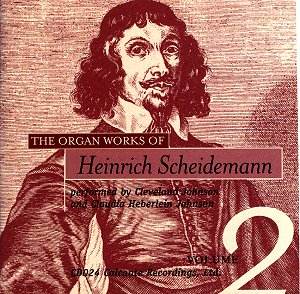 Composer: Heinrich Scheidemann
Composer: Heinrich Scheidemann
Works: Organ Works Vol. 2: Magnificat 3. Toni; Canzon in G; Vom Himmel hoch da komm ich her; Herr Christ, der einig Gottes Sohn (setting 1); Magnificat 1. Toni; Praeambulum in d; De ore prudentis procedit me; Jesu, wollst uns weisen; Lobet den Herren; Benedicam Dominum in omni tempore; In Domino laudabitur; Praeambulum in F; Nun bitten wir den heiligen Geist; Komm, heiliger Geist, Herre Gott; O lux beata trinitas; Gott sei gelobet und gebenedeiet; Praeambulum in e; A solis ortus cardine; Fantasia in G; O Gott, wir danken deiner Güt; Praeambulum in d; In dich hab ich gehoffet, Herr (setting 2); Ego sum panis vivus; Jesus Christus unser Heiland (setting 2); Durch Adams Fall ist ganz verderbt; Kyrie dominicale; Fuga; Praeambulum in g
Performers: Cleveland Johnson and Claudia Heberlein Johnson, organs
Recording: Organs in Tangermünde, Stade (Germany) and Wellesley (USA); recorded 1996 & 1997
Label: Calcante Recordings
The second volume of Heinrich Scheidemann’s organ works presents a rich tapestry of early Baroque composition, reflecting the stylistic evolution occurring in northern Germany during the 17th century. Scheidemann, a pupil of the illustrious Jan Pieterszoon Sweelinck, occupies a pivotal position in the transition from Renaissance to early Baroque idioms. His music, primarily composed for the organ, is characterized by intricate counterpoint, vibrant chorale settings, and innovative forms that prefigure the later works of Bach and his contemporaries. This recording, featuring Cleveland Johnson and Claudia Heberlein Johnson on historically informed instruments, aims to elucidate the often overlooked repertoire of this masterful composer.
The performances are anchored in a commendable understanding of Scheidemann’s stylistic nuances, particularly evident in their handling of the praeambula, which serve as a precursor to the later prelude and fugue forms. Cleveland Johnson’s interpretations largely excel, especially in works like the “Magnificat 3. Toni,” where his choice of registrations lends a colorful and dynamic quality to the piece. The use of the 1624 Hans Scherer organ in Tangermünde, with its authentic tonal palette, enhances the clarity of the intricate counterpoint, allowing the listener to appreciate the architectural beauty of Scheidemann’s writing. In contrast, Claudia Heberlein Johnson’s contributions, while technically proficient, occasionally suffer from a more rigid interpretation, lacking the expressive nuances that would further illuminate the vocal character inherent in pieces such as “Herr Christ, der einig Gottes Sohn.”
The recording quality is noteworthy, with a balanced sound that captures the distinct timbral qualities of each organ utilized. The engineers have successfully avoided the pitfalls of excessive reverb that often plague recordings of early music, ensuring that each note resonates with precision. The booklet accompanying the recording provides invaluable context, detailing the historical significance of the selected organs and offering insight into Scheidemann’s life in Hamburg, a major cultural center of the time. This contextual information enriches the listening experience, allowing audiences to engage with the music not merely as notes on a page but as a reflection of a vibrant musical landscape.
While the overall execution of the compositions is solid, the interpretative choices reveal a spectrum of expressive potential. Johnson’s performances frequently showcase a delightful inégalité, which is particularly effective in the “Fantasia in G,” where rhythmic flexibility breathes life into the music. Conversely, some passages, especially in Heberlein Johnson’s playing, feel overly uniform, lacking the vitality that characterizes the best of Scheidemann’s output. Instances where the phrasing feels rushed, particularly towards the ends of pieces, detract from the otherwise engaging interpretations.
Scheidemann’s music, when performed with the attention it deserves, has the capacity to transport listeners to a time of rich musical exploration and innovation. This recording, while not without its flaws, honors the composer’s legacy and presents a significant contribution to the understanding of his oeuvre. The choice of instruments and the thoughtful programming offer a compelling case for the revival of Scheidemann’s music in the modern repertoire.
This volume of Scheidemann’s organ works reinforces his stature as a key figure in early German organ music, even as it highlights the need for greater interpretative depth in performance. The careful registration choices and the historical instruments certainly provide an authentic platform for his music, yet the ultimate effectiveness hinges on the performer’s ability to convey the emotional weight and intricate beauty embedded in these compositions. A more nuanced approach could elevate this already commendable recording into the realm of the truly exceptional.



